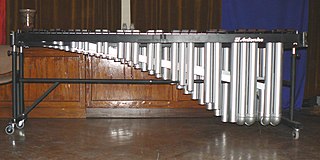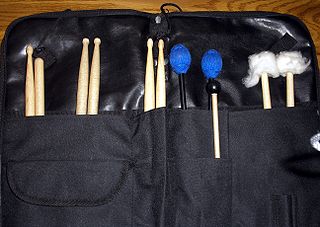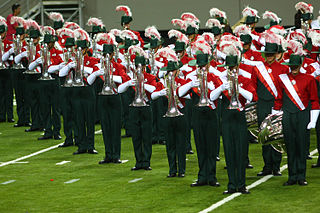This article needs additional citations for verification .(August 2013) |


A mallet percussion instrument is a melodic percussion instrument played in a particular fashion, with mallets. Mallet percussion includes:
This article needs additional citations for verification .(August 2013) |


A mallet percussion instrument is a melodic percussion instrument played in a particular fashion, with mallets. Mallet percussion includes:
The use of mallet percussion dates back at least 4,000 years to the first known xylophone. [1] Mallet percussion was first used in a modern European orchestra in 1874, [2] when Camille Saint-Saëns used a xylophone in his Dance Macabre . [3]
Modern mallet percussion instruments exist at many levels, from toy glockenspiels such as the Pixiphone popularly (non-correctly) known as xylophones, to orchestral instruments, and including many folk instruments. Many of these are diatonic, while professional mallet percussion instruments are chromatic keyboard percussion instruments, set out in a fashion similar to a piano keyboard.
Although all mallet percussion is played with types of percussion mallet, the converse is not true. Not all instruments played with percussion mallets are termed mallet percussion instruments, and not all percussion mallets are used to play mallet percussion instruments. Rather, the term percussion mallet is applied very widely, including for example tympani sticks and even drum sticks and the beaters used for untuned gongs.

A percussion instrument is a musical instrument that is sounded by being struck or scraped by a beater including attached or enclosed beaters or rattles struck, scraped or rubbed by hand or struck against another similar instrument. Excluding zoomusicological instruments and the human voice, the percussion family is believed to include the oldest musical instruments.

The xylophone is a musical instrument in the percussion family that consists of wooden bars struck by mallets. Like the glockenspiel, the xylophone essentially consists of a set of tuned keys arranged in the fashion of the keyboard of a piano. Each bar is an idiophone tuned to a pitch of a musical scale, whether pentatonic or heptatonic in the case of many African and Asian instruments, diatonic in many western children's instruments, or chromatic for orchestral use.

The marimba is a percussion instrument consisting of a set of wooden bars struck with yarn or rubber mallets to produce musical tones. Resonators or pipes are suspended underneath the bars to amplify their sound. The bars of a chromatic marimba are arranged like the keys of a piano, with the groups of two and three accidentals raised vertically, overlapping the natural bars to aid the performer both visually and physically. This instrument is a type of idiophone, but with a more resonant and lower-pitched tessitura than the xylophone. A person who plays the marimba is called a marimbist or a marimba player.

The vibraphone is a musical instrument in the struck idiophone subfamily of the percussion family. It consists of tuned metal bars and is usually played by holding two or four soft mallets and striking the bars. A person who plays the vibraphone is called a vibraphonist,vibraharpist, or vibist.

The glockenspiel is a percussion instrument composed of a set of tuned keys arranged in the fashion of the keyboard of a piano. In this way, it is similar to the xylophone, although the xylophone's bars are made of wood, while the glockenspiel's are metal plates or tubes, thus making it a metallophone. The glockenspiel, additionally, is usually smaller and, because of both its material and smaller size, higher in pitch.

A percussion mallet or beater is an object used to strike or beat a percussion instrument in order to produce its sound.

Marching percussion instruments are instruments specially designed to be played while moving. This is achieved by attaching the drum(s) to a special harness worn by the drummer, although not all marching bands use such harnesses and instead use traditional baldrics to sling their drums.

In a marching band or a drum and bugle corps, the front ensemble or pit is the stationary percussion ensemble. This ensemble is typically placed in front of the football field, though some groups will work the front ensemble into a tight pod onto the marching field. Some high school marching bands opt not to march any percussion instruments, but instead have a "full" front ensemble.

Steve Reich and Musicians, sometimes credited as the Steve Reich Ensemble, is a musical ensemble founded and led by the American composer Steve Reich. The group has premiered and performed many of Reich's works both nationally and internationally. In 1999, Reich received a Grammy Award for "Best Small Ensemble Performance " for the ensemble's performance of "Music for 18 Musicians."
Orchestral percussion are percussion instruments used in orchestras and concert bands mainly in classical music and related styles. The term can also refer to the department or study of performance on said instruments at a music school or conservatory. Generally within such a department, students are required to study all aspects of orchestral playing; with marimba, snare drum, and timpani being the three most basic areas of study. Certain core texts are studied and mastered. In timpani, for example, students are often assigned Saul Goodman's Modern Method for Timpani. Orchestral percussion usually does not include a drum set, but some compositions do require one.

Stuart Saunders Smith is an American composer and percussionist. After having studied composition and music theory at three music institutions, Smith is currently based in Vermont, America with his wife Sylvia. He has produced almost 200 compositions, half of which were written for percussion instruments with a focus on the vibraphone.
Clair Omar Musser (1901–1998) was a marimba virtuoso, a conductor and promoter of marimba orchestras, a composer, a teacher, a designer of keyboard percussion instruments, an inventor, and an engineer for Hughes Aircraft.

The percussion section is one of the main divisions of the orchestra and the concert band. It includes most percussion instruments and all unpitched instruments.

A melodic percussion instrument is a percussion instrument used to produce several different notes of different pitches. Melodic percussion instruments are examples of pitched percussion and include mallet percussion and keyboard percussion.

In percussion, grip refers to the manner in which the player holds the percussion mallet or mallets, whether drum sticks or other mallets.

A keyboard percussion instrument, also known as mallet percussion, is a chromatic melodic percussion instrument arranged in a similar pattern to a piano keyboard and played with hands or percussion mallets. Keyboard instruments for children, such as ones used in the Orff Schulwerk, may be diatonic or pentatonic.

A pitched percussion instrument is a percussion instrument used to produce musical notes of one or more pitches, as opposed to an unpitched percussion instrument which is used to produce sounds of indefinite pitch.
This is a partitioned list of percussion instruments showing their usage as tuned or untuned. See pitched percussion instrument for discussion of the differences between tuned and untuned percussion. The term pitched percussion is now preferred to the traditional term tuned percussion:

The implementation of sound technology by International Drum Corps is a phenomenon in the twenty-first century marching arts. Since 2004, many corps have used electronics to amplify, alter, and add to the sound of their ensembles.